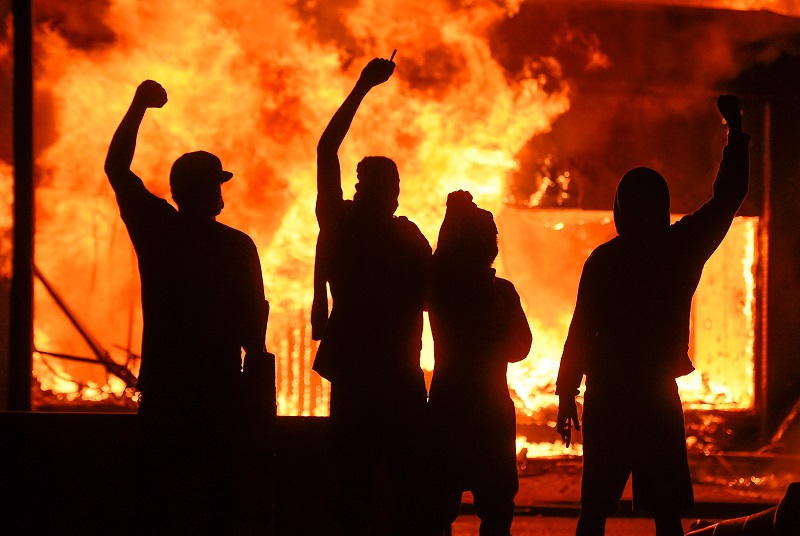

By Chief Joel F. Shults, Ed.D.
The only thing more expensive to a community than funding a police department is not having an adequately funded police department.
September’s hurricane Sally hit Alabama with an estimated destruction cost of 3 billion dollars. Like an unexpected storm, estimates from rioting related to the George Floyd in-custody death are estimated at 2 billion dollars. Those numbers are for tangible, insurable damage. Lost opportunities and lost futures are not so easily tallied on a spreadsheet.
Collateral damage
Along with the collateral damage of actual damage from arson and vandalism, the ripple effect of the Floyd protests may incur even more tragic losses, including law enforcement effectiveness. Businesses considering beginning, expanding, or relocating their operations will necessarily look at the quality of public safety infrastructure. One researcher ” reports nearly uniformly positive and often statistically significant coefficients on police and fire spending” as it relates to economic development. These measures are more concerned with the quality of service rather than merely dollars spent as a ratio of total government expenses.
What happens when those who are interested in investing in a community see police numbers going down and crime rates going up? What happens when those with capitol to invest see that the prevailing political philosophy is anti-capitalist? What happens when insurance companies pull out of a high-risk community or dramatically raise rates? What happens when property values go down and take tax revenue out of the local economy?
Enterprises vary but crime rates, insurance costs, risk management, and threat assessments are bottom line considerations for any business. New businesses know that their taxes will be funding public safety and, therefore, have a very real interest in the quality of emergency response capacity. Overall quality of life for their workers and management is measured partly by the level of safety and security.
Costs of quality law enforcement
Providing excellent policing services is an expensive endeavor. Even so, government entity spending on police as a percent of their total budget is not as high as often presumed, ranging from 4% to over 40% at the extreme high end. Staffing and equipment amid increasing demands on law enforcement have, in many cities, resulted in significant increases in expenses over the past decades. Yes, police officers have demanded more in terms of salary and benefits, but challenges in finding qualified candidates have created a supply and demand equation that favors higher compensation. But there are a lot of reasons for higher costs of operation.
The old rule of thumb for police staffing was to have one police officer for every one thousand residents. If anyone is still calculating budgets using this measure, they could not be more out of touch with modern policing. Staffing depends on the public’s expectations for service, response time, and visibility. Dense populations tend to have higher demands for services, and more sparsely populated areas cover more geography that may slow police response.
Even in the face of stable or decreasing crime rates, the time and detail that must be invested in crime response is much greater in modern policing. Processing of crime scenes, given the availability and expectation of DNA tests and scientific instrumentation, takes many hours. Jurors, conditioned to the high expectations of television cops, are reluctant to trust investigations without exhaustive DNA testing and body camera video. Time on task per officer has multiplied to avoid dropped cases and civil liability.
Contingency planning
Most citizens would be shocked at how few police officers are on shift at any given time. For officer safety and to protect the citizens and their government, multiple officers are often required at a scene. In addition, unusual events such as disturbances, major crimes, major fires, natural disaster can occur at any time. Injury and illness can strike a number of officers. Regional events can limit mutual aid assistance from other agencies. Just like in sports, police departments need a bench with enough reserve staffing to maintain high levels of service in extreme circumstances.
With every officer comes service and support staff, protective gear, special event equipment, and expensively equipped patrol and specialty vehicles, none of which are cheap.
Cost of crime
Underfunded police departments can not only discourage economic development and healthy property values. An increase in crime that will follow a reduction in the capacity of law enforcement to prevent, respond to, and effectively investigate criminal activity had direct costs. A Rand research group study in 2010 estimated that every murder inflicts a total cost of over eight million dollars when all losses and expenditures are calculated. Rape inflicts a cost of over $200,000.00, robbery $67,000.00, car theft over $9,000 as examples.
Feelings of safety, confidence in getting a 911 response, and avoiding the costs of crime are all good reasons to continue to invest in policing.